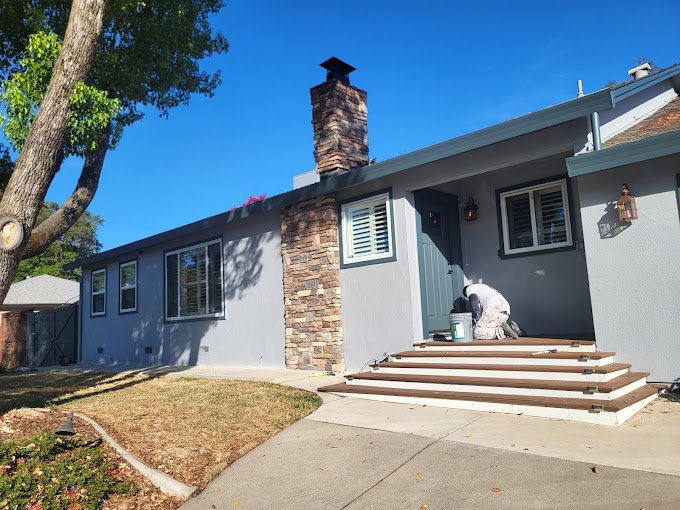A fresh coat of paint can completely transform the look and feel of your home, offering an affordable way to refresh your living space without major renovations. Residential painting is one of the most impactful changes you can make, whether updating the interior or giving the exterior a new look. Choosing the right colors, tools, and techniques is essential for achieving professional results. This guide will share practical tips to help you confidently succeed in your next residential painting project.
Choosing the Right Colors
Selecting the right colors for your home is one of the most crucial steps in any residential painting project. Start by considering the mood you want to create in each room. For example, calming shades like blues and greens work well in bedrooms, while warm tones such as yellows and oranges can energize living spaces. Neutral beige or gray colors provide a timeless backdrop that can easily complement various furniture styles.
Remember to test out color swatches on your walls before deciding. Natural and artificial light can significantly impact how a color appears at different times of the day. Lastly, consider how the color will flow with adjacent rooms, ensuring a cohesive look throughout your home that enhances the overall aesthetic.
Preparing Your Space for Painting
Proper preparation ensures a smooth and professional finish in any residential painting project. Begin by clearing the room of furniture or covering larger pieces with drop cloths to protect them from paint splatters. Next, clean the walls to remove dust, dirt, or grease, which can prevent the paint from adhering correctly. A simple mixture of soap and water works well for most surfaces.
Before painting, check for any cracks, holes, or imperfections on the walls. Use spackle or a suitable filler to repair these areas, allowing them to dry completely before sanding them smooth. Applying painter’s tape along baseboards, door frames, and windows is essential for cleaning edges and preventing accidental drips. Finally, priming the walls is crucial, mainly if you cover dark colors or paint on new drywall, as it ensures a uniform finish.
Selecting the Right Paint Type
Choosing the right paint type is essential for achieving your residential painting project’s desired look and durability. Paint comes in various finishes, each suitable for different areas of your home. Matte and flat finishes work best for low-traffic areas, such as bedrooms or ceilings, as they hide imperfections but are less durable. For high-traffic spaces like kitchens, bathrooms, or hallways, satin or eggshell finishes balance durability and subtle sheen, making them easier to clean.
Semi-gloss and high-gloss paints are ideal for trim, doors, and cabinets due to their durability and reflective finish, which can highlight architectural details. Additionally, consider the type of paint: latex-based paints are easier to work with and clean up. In contrast, oil-based paints offer superior coverage and longevity, especially on surfaces like wood or metal.
Tools and Equipment for a Professional Finish
Having the right tools and equipment is essential to achieve a professional finish in your residential painting project. Here’s a list of must-have items:
- Paintbrushes – Various sizes for detailed work and cutting in edges.
- Rollers – Ideal for covering large surfaces quickly and evenly.
- Paint Trays – These hold paint and allow for effortless loading of the roller.
- Painter’s Tape – For clean, crisp edges around trim, windows, and doors.
- Drop Cloths or Plastic Sheeting – Protect floors and furniture from paint splatters.
- Sandpaper or Sanding Block – To smooth surfaces and remove imperfections before painting.
- Putty Knife – For filling holes or cracks with spackle.
- Extension Pole – To reach high walls and ceilings without a ladder.
- Stir Sticks – To thoroughly mix paint before application.
- Ladder – For reaching elevated areas safely.
Proper Painting Techniques
Using proper painting techniques is crucial for achieving a smooth, professional-looking finish. Here are some critical steps to follow:
Cutting In
Cutting in is the process of painting edges, corners, and trim where a roller cannot reach. Use a small, angled brush for precise control. Dip the brush lightly and remove excess paint to avoid drips. Apply slow, even strokes to create clean, sharp lines. This step ensures a professional finish and prevents accidental paint overlap on areas like ceilings or trim.
Rolling
Proper technique is critical to avoiding streaks and drips when using a roller for large surfaces. Load the roller evenly by dipping it into the tray and rolling off excess paint. Apply the paint using a “W” or “M” motion to distribute it evenly. Then, fill any gaps with vertical strokes to achieve smooth, uniform coverage.
Layering Coats
For the best results, apply multiple thin coats of paint rather than one thick layer. Thick coats can lead to drips, uneven coverage, and longer drying times. Allow each coat to dry thoroughly before applying the next, which ensures better adhesion and a flawless finish. Thin coats provide even color distribution and a smooth, professional look.
Avoid Overworking the Paint
Once the paint is applied, resist repeatedly going over areas. Overworking the paint can lead to visible brush or roller marks, streaks, or even the removal of paint starting to dry. It’s best to let the paint settle naturally and touch up any imperfections after it has dried completely.
Use Proper Ventilation
Good ventilation is essential for both safety and quality during painting. Open windows and doors to ensure fresh air circulates, which helps the paint dry evenly and reduces exposure to harmful fumes. If painting in enclosed areas, use fans or air purifiers to improve airflow and minimize paint-related odors or hazards.
Safety Precautions During Residential Painting
Safety is a top priority during any residential painting project. Follow these precautions to ensure a safe and efficient work environment:
- Ventilation – Proper ventilation is essential when working with paints, especially oil-based ones that release strong fumes. Always open windows and doors to allow fresh air to circulate or use fans to improve airflow, ensuring a safe breathing environment.
- Protective Gear – Wearing protective gear like masks or respirators is crucial to avoid inhaling harmful paint fumes, particularly in enclosed spaces. Gloves protect your hands from chemicals, while goggles shield your eyes from accidental splashes, ensuring your safety throughout the project.
- Proper Lighting – Good lighting is necessary to spot imperfections and ensure even paint coverage. Inadequate lighting may lead to uneven application or missed spots, so ensure the room is well-lit, using lamps or natural light to enhance visibility.
- Ladder Safety – When using a ladder, ensure it’s placed on a stable, flat surface to avoid tipping over. Never overreach while on the ladder; reposition it to maintain balance and prevent accidents or falls.
- Keep Workspace Clear – A clutter-free workspace minimizes the risk of tripping or accidents. Remove any cords, tools, or furniture from the painting area to create a safer environment and make moving around during the project easier.
- Paint Storage – Store paint and solvents in a cool, dry place, keeping them away from heat sources or open flames, as these substances are often flammable. Proper storage reduces the fire risk and maintains the paint’s effectiveness for future use.
Hiring a Professional Painter vs. DIY
Deciding between hiring a professional painter or tackling a DIY painting project depends on several factors. DIY painting can be cost-effective and rewarding if you have the time, patience, and necessary tools. It’s a good option for smaller projects or when budget constraints are a priority. However, DIY painting requires proper preparation, technique, and attention to detail to achieve a professional-looking finish.
On the other hand, hiring a professional painter ensures high-quality results, especially for large or complex projects. Professionals bring expertise, efficient tools, and a deep understanding of surface preparation and paint application. They can handle complex tasks like high ceilings, intricate trim, or exterior painting. While it may come at a higher cost, hiring a professional saves time, reduces stress, and guarantees a flawless, long-lasting finish.
Post-Painting Care and Maintenance
Proper post-painting care and maintenance are essential for preserving the beauty and longevity of your residential painting project. Start by allowing the paint to cure fully, which can take up to two weeks, depending on the type of paint and room conditions. To prevent damage, avoid cleaning or scrubbing the painted surfaces during this time.
Once the paint has cured, clean your walls regularly with a soft, damp cloth or sponge to remove dust and grime. Use mild soap and water for tougher stains, but avoid harsh chemicals that erode paint. Consider applying touch-ups periodically to keep the walls looking fresh in high-traffic areas like hallways or kitchens.
Finally, monitor areas prone to moisture or damage, such as bathrooms or trim, to ensure the paint remains intact and vibrant over time.
A successful home makeover starts with a well-executed residential painting project. By choosing the right colors, preparing your space, and using proper techniques, you can achieve a stunning transformation that enhances your home’s appeal. Whether tackling the job yourself or considering professional help, these tips will ensure a beautiful, lasting finish.
Full Coverage Painting in Vacaville, CA, is here to help those looking to take the stress out of the process. Our experienced team offers expert residential painting services to bring your vision to life. Contact us today at (707) 384-5108 or at fullcoveragepaintinginc@gmail.com to schedule a consultation and get started on your home’s stunning makeover!







